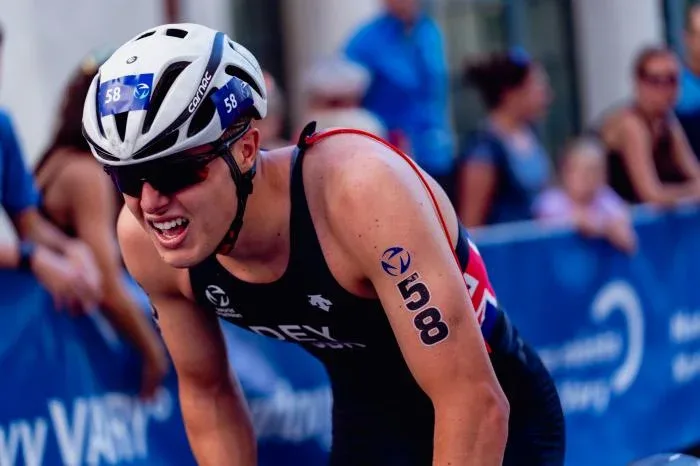Do you ever find yourself in the middle of a triathlon, pushing through the run segment, and suddenly your leg seizes up with a cramp? It can be frustrating and painful, disrupting your pace and focus.
Understanding the root causes of these cramps is crucial to preventing them in the future and optimizing your performance. While dehydration and muscle fatigue are commonly recognized culprits, delving deeper into factors like electrolyte imbalances and neuromuscular control sheds light on the complexity of this issue.
Stay tuned to uncover the intricacies of what truly causes those pesky leg cramps during running triathlons.
Key Takeaways
- Dehydration and mineral deficiencies may not directly cause leg cramps in triathletes.
- Muscle fatigue, influenced by endurance training, can disrupt neuromuscular control and lead to cramping.
- Electrolyte imbalance, especially sodium and chloride levels, can impact muscle function and increase cramp risk.
- Overexertion without proper recovery, leading to neuromuscular fatigue, is a significant factor in triggering leg cramps.
Dehydration and Leg Cramps
Dehydration is often misunderstood as the primary culprit behind leg cramps during running, but research suggests otherwise. Athletes competing in triathlons can experience over 5% dehydration without encountering leg cramps. Studies have shown that blood mineral levels remain stable in athletes suffering from leg cramps, indicating that dehydration mightn’t be the leading cause of these cramps.
Mineral deficiencies and dehydration don’t show a direct correlation with leg cramps during running. This suggests that other factors may play a more significant role in the occurrence of leg cramps during intense physical activities like running in a triathlon. So, while staying hydrated is essential for overall performance and health, it may not be the sole factor influencing leg cramps during running.
Understanding the complex interplay of various factors can help athletes better prepare and prevent cramping episodes during their races.
Muscle Fatigue Impact
Muscle fatigue during running triathlons significantly impacts neuromuscular control, increasing the susceptibility to leg cramps. When your muscles become fatigued from the intense physical demands of a triathlon, it can lead to altered neuromuscular control, affecting how your muscles function.
This altered control can disrupt muscle coordination, potentially setting the stage for cramping to occur. The fatigue-related changes in neuromuscular function can interfere with your muscles’ ability to contract and relax properly, which may contribute to cramping episodes during the race.
To combat this, focusing on endurance training is crucial. Building up your stamina and muscle endurance can help reduce the impact of muscle fatigue on your neuromuscular system, decreasing the likelihood of experiencing painful leg cramps during running triathlons.
Electrolyte Imbalance Influence
Experiencing an electrolyte imbalance can significantly impact your performance during running triathlons, affecting muscle and nerve function due to alterations in neuromuscular excitability. Electrolytes like sodium and chloride play crucial roles in nerve function and muscle contractions.
Athletes losing substantial salt through sweat are more susceptible to muscle cramps stemming from electrolyte imbalances. To prevent leg cramps during running triathlons, it’s vital to maintain proper hydration levels and balance electrolytes in your body. Studies support that consuming electrolyte-containing drinks can help reduce the risk of muscle cramps caused by electrolyte imbalances.
Imbalance in electrolyte concentrations can increase the likelihood of muscle cramping by interfering with neuromuscular function. Therefore, paying attention to your salt intake, staying hydrated, and ensuring proper electrolyte balance are key strategies to mitigate the impact of electrolyte imbalances on your performance during running triathlons.
Overexertion and Cramping
If you push your body beyond its limits without allowing for adequate recovery, you’re setting yourself up for muscle fatigue and an increased risk of experiencing debilitating leg cramps during running triathlons.
Overexertion during running triathlons can lead to muscle fatigue and a higher likelihood of leg cramps due to the strain placed on your muscles.
Intense physical activity without ample recovery time can contribute to neuromuscular fatigue, further increasing the chances of cramping during your races.
To prevent overexertion-induced leg cramps, it’s crucial to implement proper pacing strategies and follow a well-rounded training program.
Muscle overuse and lack of strength can also make you more susceptible to cramping during the running portions of triathlons.
Therefore, monitoring your training load and incorporating sufficient rest periods are essential in avoiding overexertion-related leg cramps.
Neuromuscular Control in Cramps
Exploring the intricate role of neuromuscular control in managing leg cramps during running triathlons can provide valuable insights into optimizing performance and preventing debilitating muscle spasms. Dr. Martin Schwellnus’ Altered Neuromuscular Control theory sheds light on why muscle cramps occur during running. Contrary to common belief, muscle cramps often stem from muscle overuse or lack of strength rather than just mineral deficiencies or dehydration. This theory challenges traditional notions and suggests that addressing neuromuscular control issues could be key to preventing cramping.
Recent research on pickle juice also supports this theory, indicating that muscle cramps mightn’t solely be linked to electrolyte imbalances or dehydration. The Altered Neuromuscular Control theory offers detailed explanations for the various types of muscle cramps experienced by runners. Understanding this theory better could revolutionize how athletes approach muscle cramp prevention strategies.
Conclusion
So, next time you’re training for a triathlon, remember to stay hydrated, maintain electrolyte balance, and listen to your body to avoid those pesky leg cramps.
By taking proper preventive measures and understanding the various factors that contribute to cramping, you can improve your performance and enjoy a smoother race experience.
Don’t let leg cramps slow you down – tackle them head-on and conquer your triathlon goals!
